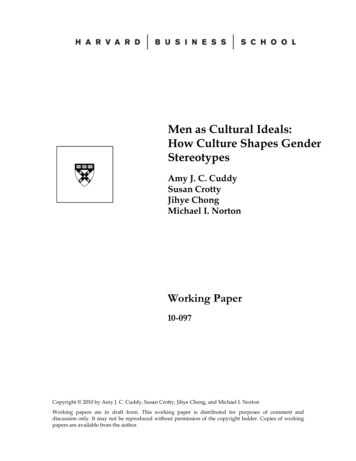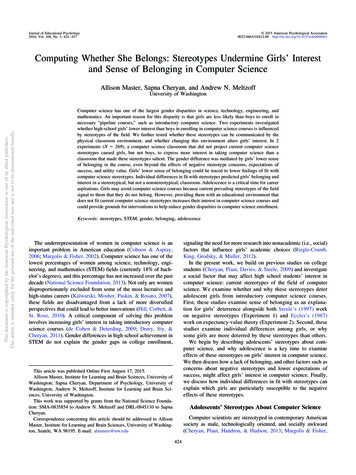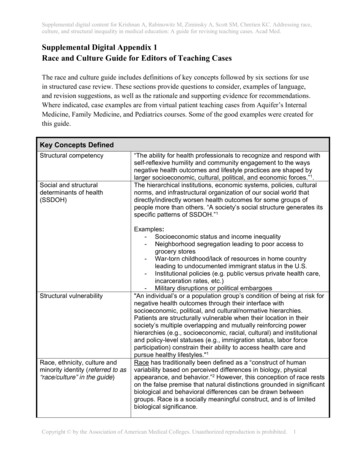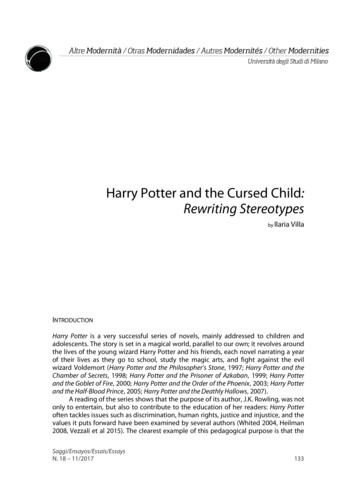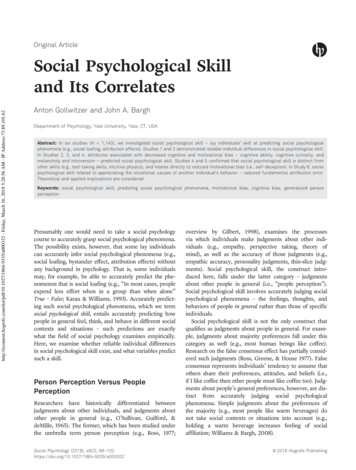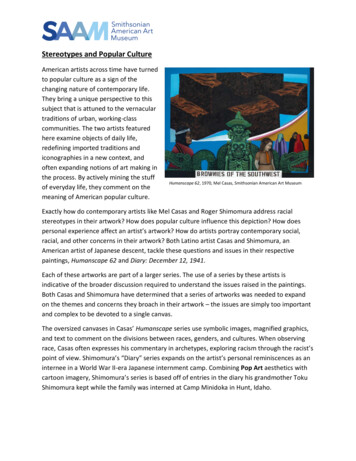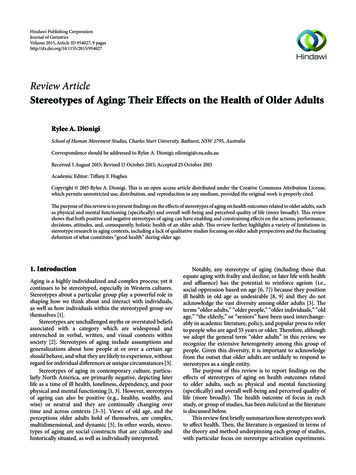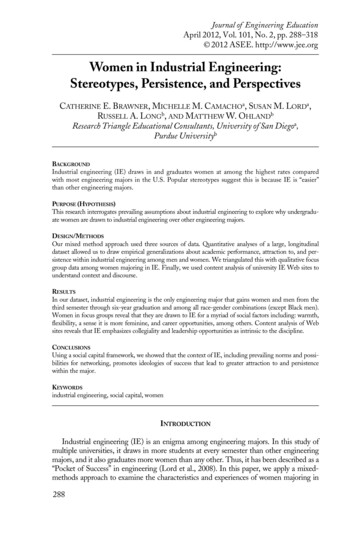
Transcription
Journal of Engineering EducationApril 2012, Vol. 101, No. 2, pp. 288–318 2012 ASEE. http://www.jee.orgWomen in Industrial Engineering:Stereotypes, Persistence, and PerspectivesCATHERINE E. BRAWNER, MICHELLE M. CAMACHOa, SUSAN M. LORDa,RUSSELL A. LONGb, AND MATTHEW W. OHLANDbResearch Triangle Educational Consultants, University of San Diegoa,Purdue UniversitybBACKGROUNDIndustrial engineering (IE) draws in and graduates women at among the highest rates comparedwith most engineering majors in the U.S. Popular stereotypes suggest this is because IE is “easier”than other engineering majors.PURPOSE (HYPOTHESIS)This research interrogates prevailing assumptions about industrial engineering to explore why undergraduate women are drawn to industrial engineering over other engineering majors.DESIGN/METHODSOur mixed method approach used three sources of data. Quantitative analyses of a large, longitudinaldataset allowed us to draw empirical generalizations about academic performance, attraction to, and persistence within industrial engineering among men and women. We triangulated this with qualitative focusgroup data among women majoring in IE. Finally, we used content analysis of university IE Web sites tounderstand context and discourse.RESULTSIn our dataset, industrial engineering is the only engineering major that gains women and men from thethird semester through six-year graduation and among all race-gender combinations (except Black men).Women in focus groups reveal that they are drawn to IE for a myriad of social factors including: warmth,flexibility, a sense it is more feminine, and career opportunities, among others. Content analysis of Websites reveals that IE emphasizes collegiality and leadership opportunities as intrinsic to the discipline.CONCLUSIONSUsing a social capital framework, we showed that the context of IE, including prevailing norms and possibilities for networking, promotes ideologies of success that lead to greater attraction to and persistencewithin the major.KEYWORDSindustrial engineering, social capital, womenINTRODUCTIONIndustrial engineering (IE) is an enigma among engineering majors. In this study ofmultiple universities, it draws in more students at every semester than other engineeringmajors, and it also graduates more women than any other. Thus, it has been described as a“Pocket of Success” in engineering (Lord et al., 2008). In this paper, we apply a mixedmethods approach to examine the characteristics and experiences of women majoring in288
101 (April 2012) 2Journal of Engineering Educationindustrial engineering. Using constant comparative analysis, a qualitative technique whereby we compare students’ responses to explore and develop common themes to examine ourdata (Corbin & Strauss 2008), we theorize that there is something different, perhaps evenspecial, about industrial engineering that makes it more attractive to women than mostother engineering disciplines. Combining three sources of data: (1) a large quantitativedata set of over 70,000 students at 8 institutions, (2) focus groups with women industrialengineering majors at three of those institutions, and (3) content analysis of industrial engineering Web sites from those institutions, we show that industrial engineering has themost women graduates of any engineering field, communicates to potential students in amanner that emphasizes inclusivity, and that the women have internalized that message intheir descriptions of the department. We focus here on women, who comprise more than36% of the industrial engineering graduates in our data set, compared with only 22% of engineering graduates overall. This aligns with National Science Foundation (NSF) data thatshow that women represent 32% of all IE graduates in the U.S. but only 20% of all engineering graduates (NSF, 2008 tab 5-4; NSF, 2008 tab 5-5). Our focus group data andWeb site analysis provide a qualitative context for understanding what attracts women toIE and frame their experiences more broadly within the field. This multi-method approach contributes nuance to our understandings of women’s successes in IE.We note that Industrial Engineering is also referred to as Industrial and Systems Engineering at some schools. Throughout this paper, we will refer to the discipline simply as industrial engineering or IE.This analysis is part of a long-term study to explore how climate and pedagogy affectthe persistence of women in undergraduate engineering programs via a longitudinal,multi-institutional, and multivariate study. Specifically, the larger project examines the research questions “How does the persistence of women engineering students vary by race,engineering major, and institution? and Can pockets of success be identified?” Industrialengineering was identified as a pocket of success. We explore the social conditions of IEthat make it gain students and particularly women from third semester to graduation andwe ask what it is about IE that makes it different from other engineering disciplines. Is IEattractive simply because it is considered easier than other engineering disciplines or is itbecause of a different value system that has evolved in the discipline that makes it attractiveto both women and men?LITERATURE REVIEWPopular stereotypes circulating among engineers suggest that industrial engineering is“easier” than other engineering majors and that industrial engineering majors are “imaginary engineers” (Foor & Walden, 2009; Trytten et al., 2004). While these ideologies mayserve to devalue and delegitimize the educational arena of industrial engineering, how isthis devaluation related to the historical sex segregation within engineering? Specifically,does IE actively market itself in a way that recruits more women, and does this result instereotyping the field as “imaginary” or “easy”? Or can the stereotypical devaluation of IEbe attributed to the fact that more women are attracted to, and subsequently graduatefrom, this field?History of Industrial EngineeringThe Institute of Industrial Engineers (IIE) defines industrial engineering (IE) as:289
Journal of Engineering Education101 (April 2012) 2[C]oncerned with the design, improvement and installation of integrated systemsof people, materials, equipment, and energy. It draws upon specialized knowledgeand skill in the mathematical, physical, and social sciences together with theprinciples and methods of engineering analysis and design to specify, predict, andevaluate the results to be obtained from such systems. (History of IIE, 2010)Practitioners also describe IE as the study of:[H]uman-centered engineered systems. This was the basis of our profession at itsorigin, and, although the form of the study has evolved, it is the basis of ourprofession today . As other engineers foster advances through innovative newtechnologies, industrial engineers deal with those technologies in theirimplementation and use. (Kimbler, 1995)Scholarship by historians of science and technology suggest that the context, case history, and historical narrative need to be examined within the systems and networks producedby social actors and their organizations (Hughes, 1986); conceptualizations of industrialengineering are similarly produced. From its beginnings, industrial engineering has transcended boundaries of disciplines and content. Pioneers in industrial engineering camefrom a variety of backgrounds including psychology, mathematics, engineering, and management and include Frederick W. Taylor, Charles Babbage, Henry R. Towne, HenryGantt, Frank, Gilbreth, and Lillian Gilbreth. IE continues to explicitly include the connection between people and technology as part of the definition of the discipline. Frankand Lillian Gilbreth are credited with bringing this human element to the forefront in thestudy of work flow.It is especially interesting that Lillian Gilbreth, the first person to earn a Ph.D. in industrial psychology in the U.S. and mother of 12 children, played such a key role in the development of the field of IE at a time when there were virtually no women in engineeringand those few were considered oddities or “engineeresses” (Bix, 2004). The Gilbreths published widely, yet several books listed only Frank Gilbreth as the author likely because atthat time, including a female author was believed to detract from the credibility of thework. After Frank’s death, Lillian continued to work in industrial engineering and was recognized with many awards. Dubbed the “First Lady of Engineering,” in 1965 LillianGilbreth was the first woman elected to the National Academy of Engineering (NAE),one of the highest honors bestowed on engineers in the U.S. (Graham, 1998). This historyframes current IE programs.The social implications of a “human-centered” engineering system allude to the coproduction of gendered ideologies and engineering.Since gender is intricately interwoven with engineering, as it is with any othersocial institution, gender and engineering are co-produced or co-constructed. Forexample, the nerd stereotype is of men who are passionate about technology but asocial; the fact that these two are posited as mutually exclusive – to be technical isto be not-social - is one of the more powerful symbolic ways in which engineeringappears gender inauthentic for women, given the strong association ofwomen/femininities with caring about people. (Faulkner, 2007, p. 334)While engineering is a heterogeneous practice, scholars have characterized the historyof its curriculum as rigid (Hacker, 1989). The theories presented by feminist technologystudies examine the “easy-hard” binary and the social construction of what it means for a290
101 (April 2012) 2Journal of Engineering Educationdiscipline to be labeled “hard.” What is characterized as hard often translates into technical. While engineering practice in general contains elements of both technical and social,the technical is normative, while the social is less visible—these distinctions map onto thedualism of technology as masculine and sociality as feminine (Faulkner, 2000, 2007). Thisdualism between the technical and social is at the heart of the so-called “imaginary” conceptualization of industrial engineering (Foor & Walden, 2009).Perception of Industrial Engineering as an “Easy” DisciplineTo understand the basis and consequences of the stereotype that industrial engineeringis easy, we explored the foundation of how disciplines have previously been classified in ahierarchical sense. Specifically, the description of industrial engineering as “Imaginary Engineering” recalls the notion that the sciences can be classified on a spectrum from “soft” to“hard.” A hierarchy of disciplines was published over a century ago by Auguste Comte(1896), classifying disciplines focusing on positivist approaches as “hard,” and by inference,superior to other disciplines. Subsequent work by Beyer, Lodahl, and Gordon (1972) andSmith, Best, Stubbs, Johnston, and Archibald (2000) paralleled Comte’s conclusions andadvanced the measurement of “hardness” from an ordinal scale to an interval scale. Thetrend toward refining the measurement of “hardness” is an indication that it is a widely accepted notion.Two perceptions that Foor and Walden (2009) identified as separating industrialengineering from other engineering disciplines were distance from technology and aless rigorous curriculum. What Foor and Walden call “distance from technology” hasstrong parallels to themes in earlier research that would describe this distinction as “lesslikely to use graphs,” “softer,” and “less positivist.” Students in the 2006 study by Murphyet al. attribute some of the perception that IE is easier than other engineering disciplines to a lack of understanding of what IEs do. Murphy et al. label this as the “invisibility” of IE. We interpret this to mean that students coming to college do not knowwhat IE is and therefore do not choose it as a major on entry, rather they make thischoice after they learn what the major offers them and how it fits with their academicand career needs. If industrial engineering is stereotyped as easier than other engineering disciplines, it is easier to marginalize the discipline, because engineering has beenfound to operate as a meritocracy of difficulty (Stevens, Amos, Garrison, & Jocuns,2007). Engineering students are socialized to believe that engineers work harder thanothers. The higher starting salaries engineering graduates earn reinforce this belief,given that a meritocratic value system informs their beliefs. Once students adopt thisbelief, working hard is the primary way to judge the value of an engineer or a disciplineof engineering. Further, this belief enables a willingness to sacrifice experiences common to other college students and shapes how engineering students define who belongsin engineering and how they view and interact with non-engineers. This belief supportsthe hegemony of engineering as a major and, most important to this discussion, a hierarchy of engineering disciplines—as students in the Stevens et al. study indicated, “EEis more prestigious than Industrial Engineering because it is harder” (2007, p. 8). Importantly, Stevens et al. found that this belief is well supported by the faculty and cultures of engineering education. The message that engineering is hard, therefore, is apart of the discourse of engineering students, and that difficulty is a source of prestigeand pride. If IE is perceived as less difficult, we can conclude it will be devalued withinthe cultural context of engineering’s hierarchical and socially constructed meritocracy.291
Journal of Engineering Education101 (April 2012) 2Industrial Engineering Attracts WomenMany studies that focus on the climate for women in science and engineering aggregateengineering with other STEM disciplines or at best only discuss engineering in the collective (Blakemore & Low, 1984; Hill, Corbett, & St. Rose, 2010; Jacobs, 1995; Seymour &Hewitt, 1997). The relative attractiveness of the individual disciplines within engineeringis not discussed, only that the field in its entirety does not generally attract large numbers ofwomen. However, in a cultural analysis, Godfrey (2007) showed that different engineeringdisciplines exhibited different cultures, which affected women’s participation. Thus it isimportant to examine specific disciplines. Studies that do include separate results for industrial engineering are highlighted below.Following a cohort of about 1000 students at one institution, Humphreys and Freeland(1992) found differences in retention by gender and department. Industrial engineeringhad 35% women at matriculation and was third among the eight engineering disciplinesstudied in percentage of women at matriculation and graduation. Marra, Bogue, and Shen(2008) found that women and men majoring in engineering at one university were statistically indistinguishable on 95% of items on a lengthy survey about classroom activities suchas instructor-student, student-student, and teaching assistant-student relationships. Theyfound, however, that there were many statistically significant differences when answers tothese same questions were compared among the industrial, mechanical, and engineeringscience and mechanics departments. Lord et al. (2009) showed that there were gender differences in major selection within engineering, but did not explain why these differencesexist.In one of the few studies to examine critically sex segregation across engineering majors, Litzler (2010) combined data from the Engineering Workforce Commission (EWC)and the Project to Assess Climate in Engineering (PACE) survey to explore both individual and institutional factors that might explain why certain engineering majors have relatively higher or lower percentages of women compared with the representation of womenoverall in engineering. The EWC data contains information from all of the schools of engineering in the U.S. while the PACE data includes 21 generally large, public, research intensive universities. Litzler’s analysis included the implications of human capital theory(which would allow easy exit and re-entry into the field), status beliefs related to the socialization students receive about the discipline, and discrimination and hostile climate. Sheexamined nine engineering majors that were common to most of the PACE schools,specifically aerospace engineering, biological engineering, chemical engineering, civil engineering, computer engineering (including computer science), electrical engineering, industrial engineering, material science engineering, and mechanical engineering.At the individual level, Litzler (2010) found that prior experience with engineeringpulls students toward highly male-dominated fields such as electrical, computer, and mechanical engineering. A positive climate generally pulls students into majors with a higherproportion of women. Similarly, she found a higher proportion of women in majors thatwere perceived to be family-friendly with greater support from faculty. The proportion ofwomen in the major, however, was not the defining characteristic for women’s choice ofmajor. Rather, individual-level characteristics were more important than institutional variation in women’s major selection overall. Forty percent of the variation in the choice of industrial engineering over bioengineering (her reference discipline), however, is attributableto variation between schools compared with less than 5% of the variation for chemical andmechanical engineering relative to bioengineering. The main point here is that context isimportant, particularly in the choice of industrial engineering by women. Litzler’s findings292
101 (April 2012) 2Journal of Engineering Educationare generalizable to large public institutions that are highly ranked and have a high level ofresearch activity, similar to most of the institutions in our data set.The most extensive study of women (and men) in industrial engineering was carriedout by a team at University of Oklahoma (OU) in the early 2000’s (Foor & Walden, 2009;Foor, Walden, & Trytten (2007); Murphy, Shehab, Reed-Rhoads, & Trytten, 2006;Murphy et al., 2007; Shehab, Reed-Rhoads, & Murphy, 2005; Trytten et al., 2004;Walden & Foor, 2008). During that time, the industrial engineering department at OUachieved gender parity among undergraduates, doubling from 27% in 1996 to a high of58% women in the Fall of 2001 without any particular programs in place to address thegender balance in the department (Murphy et al., 2007). The authors note that after thestudy, female enrollment in the department reverted to 39% and 34% in the Fall of 2004and 2005 respectively. They attribute the decline to the graduation of student “ambassadors” for the IE program and to one of the female faculty members giving birth to twochildren which limited her visibility among students. In the OU case, as in the Litzler(2010) study, context framed outcomes.The OU study included interviews with 185 women and men from IE departments atOU and three other universities and from three other engineering departments at OU toprovide contrast. They also interviewed most of the IE faculty at OU. Students from allfour institutions described IE as a discipline using terms such as (in decreasing order of frequency): people-oriented (80%), emphasizing efficiency (77%), emphasizing business aspects of a problem (64%), breadth of the discipline (61%), problem solving (56%), communicators (51%), systems-oriented perspective (49%), expedient way to advance intomanagement (47%), and status potential, which was particularly important to women(57% vs. 40% of the men). With respect to department culture, the authors note the IE department at OU had a relatively large proportion of women faculty (4/13) and that womenwere in positions of authority—one was department chair and another was associate dean.The department also actively recruited students by personal invitations from the department chair, presentations by faculty and students at Society of Women Engineers (SWE)events, freshman seminars, and College of Engineering (COE) recruiting events; andthrough brochures and on a continually updated Web site. Students were given personalattention by faculty and considered themselves to be friends with other students. Overall,the department exuded a sense of community for the faculty and students.Using the same set of interviews, Foor and Walden (2009) discuss how men and womennegotiate gendered identities for themselves in the “borderland” that is industrial engineering. In this borderland, IE serves as a boundary between the harder and more technical engineering disciplines, like chemical or electrical, and the academic world that lies outside ofthe college of engineering, particularly business. The pejorative concept of “imaginary engineering” is used by the interviewees who have internalized messages received from peers inother majors that IE, because it is perceived as less technical, must somehow be easier andthe last stop on the road to a business degree for people who are not able to succeed as engineers. It is in this context that women and men both have created identities that allow themto feel comfortable with their choice. For women and men, IE offers the ability to be engineers while not being “weird.” For women, this means that they can be feminine and havefamilies, while still being professional, something modeled by the women IE faculty at OU.For the men, they can be engineers without being socially isolated or geeky—they can be“normal” people. The authors conclude that IE, as a borderland, is a place where therenegotiated identities “might shift boundaries and produce real transformations inengineering diversity” (Foor & Walden, 2009, p. 58).293
Journal of Engineering Education101 (April 2012) 2Social Capital Framework for Industrial EngineeringIn deepening our analysis of the context of IE, some of the findings in the literaturecited above may be related to the acquisition of “social capital.” According to StantonSalazar and Dornbusch (1995), social capital refers to “a set of properties existing withinsocially patterned associations among people that, when activated, enable them to accomplish their goals or to empower themselves in some meaningful way” (p. 10). Researchersin engineering education have begun to use the theoretical framework of social capital tounderstand how social networks and social norms are valued (Brown, Flick, & Williamson2005; Daily, Eugene, & Prewitt, 2007; Trenor, Yu, Waight, & Zerda, 2008). Foor,Walden, and Trytten (2007), for example, suggest that social capital in engineering education comes in a myriad of forms, including “having a parent who is able to forward theirchild’s resume for a summer internship to a friend working at a company that hires engineers” (p. 106). These researchers draw on sociologist Pierre Bourdieu’s influential workon social reproduction in which he identifies the social and cultural mechanisms that promote success and social status (Bourdieu, 1984). Applied to IE, the theory of social capitalrefers to instrumental relationships between IE students and institutional agents (e.g., faculty, administrators, advisors) who promote perceptions of success. The theory of socialcapital would suggest that the successful social integration of students in IE depends uponconstructing instrumental relationships with institutional agents who will transmit information about and cultivate student opportunities for success. For example, in IE this includes transmitting information about diverse career paths, the importance of IE’s leadership for improving business flows and processes, and the intellectual contributions andtransformative potential IE possesses to make an impact on the industrial economy.In other engineering majors, social capital is, arguably, more difficult to acquire forwomen because of the gendered, male-dominated, context that dates back to the militarized history of engineering as a discipline with its notoriously rigid curricular structurethat limits migration into the major (Hacker, 1989). With its emphasis on social relations and networks, IE promotes social capital and challenges some of these barriers.Throughout this work, we assert that IE broadens the social frame of reference for students and makes evident the importance of connections to people in industry and theirpotential impact. It also provides experiences that produce attitudes conducive to network building. It emphasizes the necessity of a plurality of voices in the workforce,shows value for diverse modes of operation, and promotes innovation and flexibility ascreative skill sets. IE is oriented to enhance student support networks and develop skillsas a strategy for success. Therefore IE conveys social capital as a set of actual and potential resources. IE communicates to students that they have the ability to tap a range ofties within the broad network of the IE field and benefit from these ties. Using a mixedmethods analysis, our goal in this paper is to build upon the theories presented by othersand use a social capital framework to expand the conception of industrial engineering asa unique space for women.METHODSWe use a mixed methods design, combining quantitative and qualitative research tolearn about the systemic issues that cause a relatively high percentage of women tochoose to be industrial engineering majors. Our quantitative study is anchored in theMIDFIELD database, described below, and allows for generalizability of student major294
101 (April 2012) 2Journal of Engineering Educationselection behavior to large public institutions. Qualitatively, we use focus groups andcontent analysis of IE program Web sites to develop a more complete understanding ofstudents’ motivation for selecting industrial engineering and the messages they receiveabout the discipline. We describe what the students are experiencing and how they areexperiencing it both through their voices and through formal channels such as Websites. Using these qualitative data as part of our overall analysis helps us to validate, interpret, clarify, and illustrate the quantitative findings from MIDFIELD (Miles &Huberman, 1994).The choice of this design stemmed from our analysis of MIDFIELD data. We founda relatively large number of women graduating in IE. We wanted to explore this furtherthrough focus groups to learn the meanings and motivations behind why women major inIE. During the focus groups, students often discussed the impact of the IE departmentalWeb sites in attracting them to the major. We conducted an exploratory content analysisof the IE Web sites to provide a backdrop for the women’s narratives. These three sourcesallow us to explore and explain findings from each.Quantitative DataThis study uses the Multiple-Institution Database for Investigating Engineering Longitudinal Development (Long, 2008; Ohland et al., 2008), a data set with more than79,000 students matriculating in engineering at nine southeastern U.S. institutions thatawarded 1/12th of all U.S. engineering bachelor’s degrees from 1987 to 2004. Included inMIDFIELD are two historically black colleges and universities (HBCUs). Because we arestudying only industrial engineering in this research, we excluded from this study the oneMIDFIELD school that did not offer an IE degree during our timeframe. This resultedin approximately 3,000 students being deleted. We focus on first-time-in-college U.S. citizens and permanent residents. Gender and race/ethnicity are self-reported by studentschoosing among Asian, Black, Hispanic, Native American, Non-Resident Alien, Other,and White. We exclude those students who chose Non-Resident Alien or Other fromthis study since those categories each aggregate students such that findings are uninterpretable. Since we have whole population data, inference is unnecessary—all reported differences are valid within this population. Graduation is defined as having graduated by thesixth year following matriculation, the standard of reporting used by the Integrated Postsecondary Education Data System (IPEDS) (U.S. Department of Education, 2007).Thus, we consider students who matriculated from 1988–1998 and had graduated sixyears later. While we did not include transfer students, they are the subject of a separatestudy currently under way by MIDFIELD researchers.Two institutions in this data set have first-year engineering (FYE) programs, meaning that students at these institutions cannot matriculate directly into any specific engineering major including IE. Thus, to include students at all institutions, we do not reportnumbers of students at matriculation but instead report numbers of students enrolled inIE at the end of Semester 3 (by which point first-year engineering students are expectedto have chosen a major) and six-year graduation. Note that there are over 12,000 engineering students in the database who had not declared a major by the end of Semester 3.They may be undecided or still in an FYE program (Brawner et al., 2009). Some of thesestudents, along with people who transfer into engineering from non-engineering majors,do appear in the graduation data as they declared an engineering major after the third semester and subsequently graduated. We use six-year graduation because it is a measure of295
Journal of Engineering Education101 (April 2012) 2educational progress that can be compared to other published data (U.S. Department ofEducation, 2007; National Collegiate Athletic Association, n.d.). We count only enrolledsemesters to Semester 3 to ensure that this earlier measure also measures actual educational progress.Focus GroupsWe held focus groups with a total of 20 women undergraduates majoring in industrialengineering at three MIDFIELD institutions during the 2009-2010 academic year. Theinstitutions chosen represent the range of instituti
sistence within industrial engineering among men and women. We triangulated this with qualitative focus group data among women majoring in IE. Finally, we used content analysis of university IE Web sites to understand context and discourse. RESULTS In our dataset, industrial engineering is the only engineering major that gains women and men .
